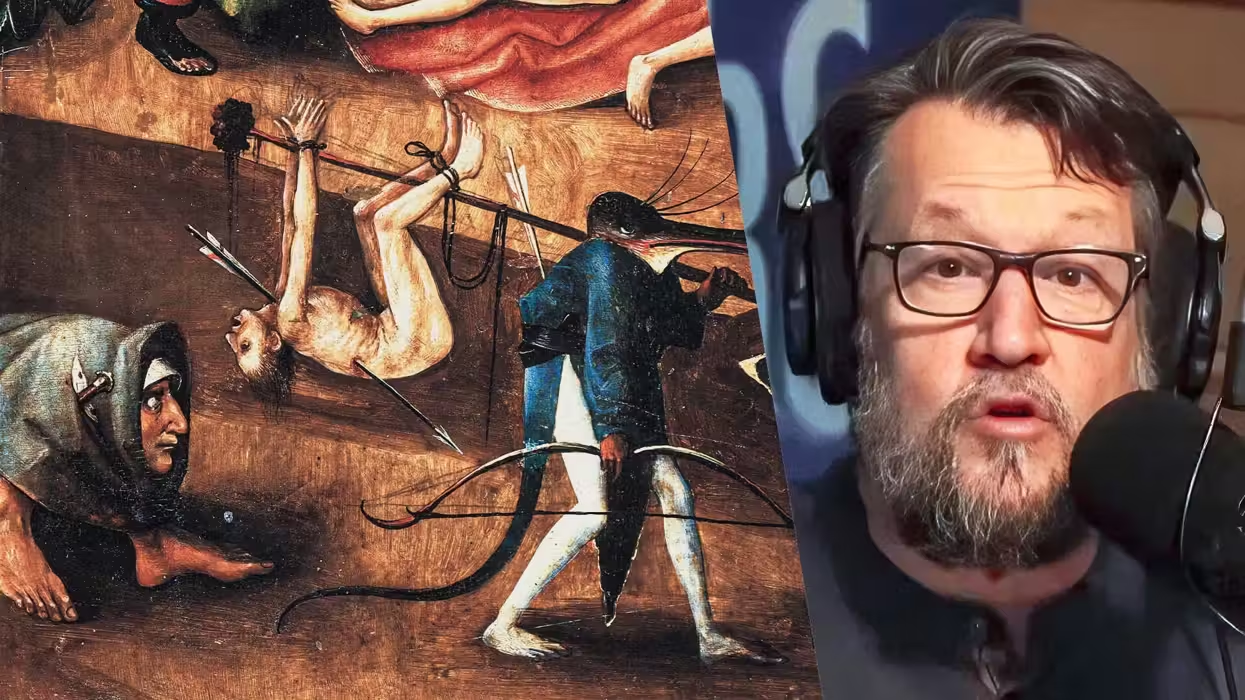
© 2025 Blaze Media LLC. All rights reserved.
America lost a patriot, Hall of Fame baseball player, legendary broadcaster of over five decades and a kind, humble and decent human being.
Ralph Kiner was born Oct. 27, 1922 in Santa Rita, N. M.
Raised in Alhambra, Cali. to Beatrice Grayson, a nurse during World War I in France and Ralph Macklin Kiner, a baker, Ralph Kiner sadly did not get to experience the boyhood rite of passage of playing catch with his father. Ralph Macklin Kiner passed away when his son was only 4-years-old. Kiner would find and fall in love with the game of baseball only through the encouragement of one of his neighbors.
As "AP" noted, these high school days were special: Kiner would hang around the Pacific Coast League's Hollywood Stars and hobnob with the all-time greats of baseball such as Babe Ruth and Ty Cobb. He also hit a homerun off Satchel Paige during a barnstorming tour.
Upon graduation from Alhambra High, Kiner signed with the Pittsburgh Pirates and headed to the minor leagues where he would start his career in Albany. On Dec. 7, 1941, the 19-year-old Kiner was playing in a semi-pro game in Pasadena when the news struck that Pearl Harbor had been attacked. Kiner noted:
"Upon hearing about the attack, we all immediately said the same thing: You can't do that to this country! The next day, instead of playing baseball, I went and enlisted in the United States Navy. It happened that fast."
He would not be called into service until early in the 1943 season, while playing for the Toronto Maple Leafs, the Pittsburgh Pirates' Double-A affiliate.
 Ralph Kiner's Naval Aviator Certificate. (Image Source: mydesert.com)
Ralph Kiner's Naval Aviator Certificate. (Image Source: mydesert.com)
Kiner served in the Navy as a fighter pilot, flying anti-submarine missions in the Pacific, initially as a navigator, in a time before there was radar.
Ralph Kiner was honorably discharged on Dec. 5, 1945, having barely played any baseball at all during his time of service. Kiner said:
"Though I rarely got on the field myself, I wasn't jealous of those who did. Everyone who volunteered for the service possessed a singular focus on saving this country. I never felt like I was missing out on anything because I was doing exactly what I was supposed to be doing. For all of us ballplayers in the service, our duty to our country was always more important than playing baseball."
He acknowledged that other baseball greats like Ted Williams were not so lucky:
“The guys that stayed in the reserves got called back during Korea. That’s what happened to Ted Williams.“Williams was called back. He had to serve time in the Marine Corps. He was one of the greatest hitters, if not the greatest hitter. He was more proud of being a Marine than being in the Hall of Fame.”
One gets the sense that though his Naval service reads as a footnote, this might be more attributable to modesty than a lack of valor.
Now 23-years-old and having grown from a boy to a man both physically and mentally, the hulking 6 foot 2 inch 195 pound Kiner came to Pirates Spring Training in 1946 and made the club, hitting 23 homeruns during his rookie year to lead the National League. The next year he would club 51 homeruns, leading sportswriters to rename "Greenberg Gardens," the left field area of Pittsburgh's Forbes Field named for the great power hitter Hank Greenberg to "Kiner's Korner" for all of the homeruns Kiner hit to that spot. He had become a superstar in just two short years.
 Hank Greenberg (left) and Ralph Kiner (right) pictured during 1947, the last year of Greenberg's career and the second year of Kiner's. (Image Source: The Sporting News)
Hank Greenberg (left) and Ralph Kiner (right) pictured during 1947, the last year of Greenberg's career and the second year of Kiner's. (Image Source: The Sporting News)
Kiner's career as a Major Leaguer would span only 10 years due to a back injury, but he made those 10 exceptional years count. Kiner was the Babe Ruth of his day, minus the drinking, carousing and absenteeism. His homerun hitting prowess in a sport in which statistics and records are everything earned him two distinctions that remain to this day -- Kiner holds the Major League record for homeruns in the first five seasons of a career and led the National League in homeruns for a record seven straight seasons, doing so on the perpetually putrid Pittsburgh Pirates. He slugged over 50 homeruns in a season twice in an era in which the only performance enhancer was a dark cup of coffee.
When all was said and done, Kiner retired in 1955 a six-time All Star, crushing 369 homeruns during his Major League career, a prodigious rate per season that earned him a spot in the Hall of Fame in 1975.
While Kiner was Pittsburgh, he was also Hollywood. Bing Crosby, a minority owner of the Pirates took a liking to Kiner and brought him into his inner circle, even arranging for Kiner to escort a 17-year-old starlet named Elizabeth Taylor to a movie premiere. He also starred in "Angels in the Outfield," a 1951 movie where he played himself. Kiner built a house in Palm Springs before Palm Springs was Palm Springs, and counted among his friends and neighbors Frank Sinatra, Lucille Ball and Desi Arnaz.
 Ralph Kiner and Elizabeth Taylor. (Image Source: Bob Lemke's blog)
Ralph Kiner and Elizabeth Taylor. (Image Source: Bob Lemke's blog)
Having retired at 32 years old, Kiner remained in baseball, signing on as the General Manager for the Minor League San Diego Padres. During this time, Kiner got his first taste of broadcasting, as the club was too poor to hire an announcer, so he took the job himself. In 1961 he was employed by his old friend and former teammate Hank Greenberg to announce games for the Chicago White Sox. In 1962, he departed for New York's new National League expansion team, the Mets.
As Kiner tells it "The Mets hired me because they looked at my background with the Pirates and saw that I had losing experience."
They promptly lost 120 games while winning only 40 in their first season. But just seven years later in 1969, the Mets rose from last to first in one of the great miracles in sports history, winning the World Series against the heavily favored Baltimore Orioles the same year that man first walked on the moon.
Kiner would serve as an announcer for the Mets for the rest of his life. During those 52 years, he would become famous for his post-game show "Kiner's Korner," which he hosted beginning in 1964 and continued to run after every Mets home game for decades. All of the greats during that period from Hank Aaron to Willie Mays to Pete Rose to Tom Seaver clamored to be on the show.
As many have noted, Kiner was also known for various verbal gaffes or "Kinerisms" which didn't much bother anyone and in the end only served to add to his charm and further distinguish him from the pack.
 Mets Hall of Fame pitcher Tom Seaver talking with Ralph Kiner on an episode of "Kiner's Korner" on 5 April, 1983. (Image Source: Youtube screengrab)
Mets Hall of Fame pitcher Tom Seaver talking with Ralph Kiner on an episode of "Kiner's Korner" on 5 April, 1983. (Image Source: Youtube screengrab)
But despite any shortcomings, even in these last few years in his late eighties, Kiner could still tell you what David Wright was doing wrong at the plate, what Hank Greenberg might have done to fix it, and how much harder it was to hit against Satchel Paige than the current crop of southpaws.
His memory was simply staggering and his ability to tell a mesmerizing story equally likely to leave you laughing as shaking your head was unmatched.
Perhaps most importantly, story after story describes Kiner as a kind, decent gentlemen, who as his agent noted during an interview would never let you know of his greatness as a player or announcer. Indeed the only thing greater than his life in baseball was his humility.
As an 11 year-old in 1999 traveling through California with my family following around my beloved Mets, I met Kiner during breakfast at the team hotel in Los Angeles. I distinctly remember first how dapper the man was, and second how he took the time away from his breakfast to say "Hi" and autograph my cap. Maybe it's just my selective memory, but you could see and feel a certain aura of warmth around this shrinking old man.
He left a lasting, positive impression on me and I only got to see him for his last 20 years in the broadcast booth. I can only imagine what he meant to those who listened to him for the first 30 years too.
In so many ways this genial California kid reminds us of another California transplant who also announced baseball games, starred in movies and spun great stories, who was born the same day Kiner died: Ronald Reagan.
Ralph Kiner was a patriot, a Hall of Fame baseball player, a beloved Mets announcer of 52 years, a kind and humble grandfatherly figure for two generations of New Yorkers, a connector of fathers and sons and a familiar voice on many a sweltering summer day.
His death at 91-year-old somehow feels as if he was taken from us too soon.
He will be sorely missed by the five children and 12 grandchildren who survived him, along with millions of fans throughout the world.
They don't make men like Ralph Kiner anymore.
–
TheBlaze contributor channel supports an open discourse on a range of views. The opinions expressed in this channel are solely those of each individual author.
Want to leave a tip?
We answer to you. Help keep our content free of advertisers and big tech censorship by leaving a tip today.
Want to join the conversation?
Already a subscriber?
Ben Weingarten is a writer, commentator, and editor at large at RealClearInvestigations. He is a senior contributor at the Federalist and writes columns for Newsweek and the Epoch Times.
Ben Weingarten
Ben Weingarten is a writer, commentator, and editor at large at RealClearInvestigations. He is a senior contributor at the Federalist and writes columns for Newsweek and the Epoch Times.
more stories
Sign up for the Blaze newsletter
By signing up, you agree to our Privacy Policy and Terms of Use, and agree to receive content that may sometimes include advertisements. You may opt out at any time.
Related Content
© 2025 Blaze Media LLC. All rights reserved.
Get the stories that matter most delivered directly to your inbox.
By signing up, you agree to our Privacy Policy and Terms of Use, and agree to receive content that may sometimes include advertisements. You may opt out at any time.






